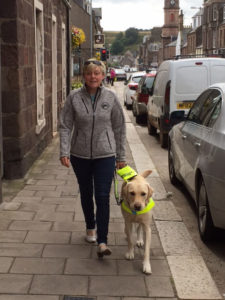By Dr Mary Fraser
As vets and veterinary nurses we’re taught how to work with animals and clients. However, when working in practice I noticed that some colleagues found it awkward talking to owners of guide dogs or hearing dogs as they didn’t know what was expected of them, and were worried about offending someone by saying the wrong thing. So with this in mind I set about designing a study where we talked to owners of guide dogs to find out more about their experiences, identify what worked well in practice and why, and also discover what went wrong. I hoped that from this, we would be able to design some training for current students and practitioners in how to work with owners of assistance dogs.
So, what were the findings? Well, the first thing to mention is that overall the findings were very positive with many good experiences. Everyone had something good to say about their vets. This often focussed on consistency and routine: meeting familiar staff, including reception, nurses and vets who knew the dog and owner. Difficulties arose where new staff were present who didn’t know that the owner would weigh the dog before going into the consultation, that the dog shouldn’t be given treats or that it shouldn’t be distracted as it was working.
Good communication is essential to vet practice
Do you remember older vets talking about the ‘art’ of veterinary practice? This also applied to working with guide dog owners. Some owners found that if nothing was said in the consultation and they couldn’t see what was happening to the dog they felt isolated. They also worried about their dog as they didn’t know that it was only jumping because it was having its temperature taken – warning the owner about what was going to happen would have been helpful.
Sometimes vets didn’t fully appreciate the bond between owners and their dog. Every owner worries about their pet and many will treat them as part of the family. For guide dog owners though there is an even stronger bond. People rely on their dogs to go about their daily life and they spend all of their time with them. From this, owners were able to pick up subtle differences in their dog’s behaviour, or detect changes in movement through the harness (things that showed the dog was ill, sometimes before even the vet could pick it up on clinical examination). This, however, led to difficulties, as owners felt that sometimes vets didn’t believe them when they said there was something wrong with their dog.
Like any other dog, guide dogs need preventive healthcare and may need to be given medication at home. Many guide dog owners will be perfectly happy to apply drops or flea medication or give tablets, but they might not. So just take the time to ask if they are OK with the format the medication comes in. If not, do you have a different preparation that might be more suitable? We came across some ingenious methods of adapting syringes or droppers to make them more user friendly to both the owner and the dog. Where dogs were receiving multiple medications, then think about ways that they can be differentiated. If sending owners home with instructions then what format would suit best; emails or MP3s might be worth thinking about, although most owners were happy to remember instructions and knew they could phone the practice if they had any queries.
So where do we go from here? I hope that some practitioners/students out there will read the research and find it helpful in practice. I would be delighted if the vet schools could incorporate some of this into their communication training, but I know their curriculum is already full! Training staff in sighted guiding would also be beneficial to practices, so if you want to find out more please go to Guide Dogs website. I was recently asked what was the most important point to take from this research and my answer was ‘just ask if you can help.’
Acknowledgements: Thanks to Pamela Munro, Emma Brown, Julie Millar of Guide Dogs Scotland and all the owners and dogs who gave up their time to take part in the research.
Photograph: Shona Black with guide dog Woody. Photograph courtesy of Pamela Munro, Guide Dogs Scotland.
